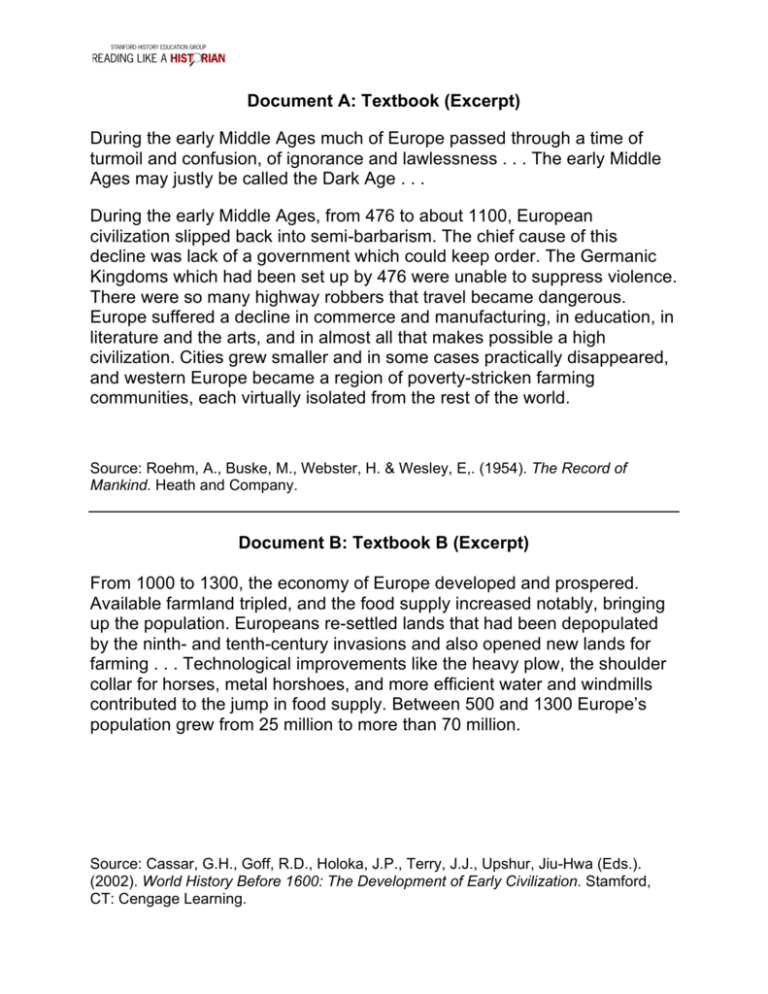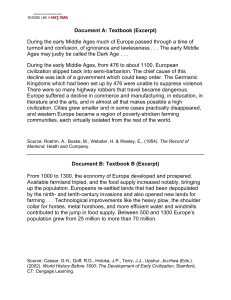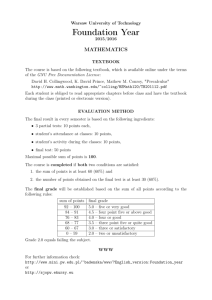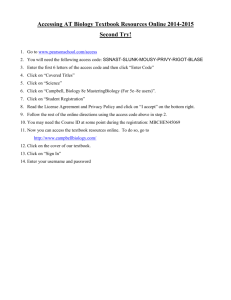Document A: Textbook (Excerpt) During the early Middle Ages much
advertisement

Document A: Textbook (Excerpt) During the early Middle Ages much of Europe passed through a time of turmoil and confusion, of ignorance and lawlessness . . . The early Middle Ages may justly be called the Dark Age . . . During the early Middle Ages, from 476 to about 1100, European civilization slipped back into semi-barbarism. The chief cause of this decline was lack of a government which could keep order. The Germanic Kingdoms which had been set up by 476 were unable to suppress violence. There were so many highway robbers that travel became dangerous. Europe suffered a decline in commerce and manufacturing, in education, in literature and the arts, and in almost all that makes possible a high civilization. Cities grew smaller and in some cases practically disappeared, and western Europe became a region of poverty-stricken farming communities, each virtually isolated from the rest of the world. Source: Roehm, A., Buske, M., Webster, H. & Wesley, E,. (1954). The Record of Mankind. Heath and Company. Document B: Textbook B (Excerpt) From 1000 to 1300, the economy of Europe developed and prospered. Available farmland tripled, and the food supply increased notably, bringing up the population. Europeans re-settled lands that had been depopulated by the ninth- and tenth-century invasions and also opened new lands for farming . . . Technological improvements like the heavy plow, the shoulder collar for horses, metal horshoes, and more efficient water and windmills contributed to the jump in food supply. Between 500 and 1300 Europe’s population grew from 25 million to more than 70 million. Source: Cassar, G.H., Goff, R.D., Holoka, J.P., Terry, J.J., Upshur, Jiu-Hwa (Eds.). (2002). World History Before 1600: The Development of Early Civilization. Stamford, CT: Cengage Learning. Document C: Abbey of Xanten Records (Modified) The following document is from the yearly records of the Abbey of Xanten, a city in modern day Germany. An abbey is a place where Catholic monks and nuns live. The document describes Europe’s troubles in the mid ninth century. It focuses on invasions by heathens, or non-Christian barbarian tribes. Specifically, it mentions the Vikings, or “Northmen,” and Saracens, Arab tribes. Most of the names mentioned are cities or areas in Germany. Gaul is basically modern day France, and Christendom is the Christian part of Europe. 845 Twice in Worms there was an earthquake. In the same year the heathen broke in upon the Christians at many points, but more than twelve thousand of them died. Another party of invaders devastated Gaul, and more than six hundred of them died. 846 According to their custom, the Northmen plundered eastern and western Frisia and burned down the town of Dordrecht, with two other villages, before the eyes of Lothair [The Emperor]. He was in the castle of Nimwegen but could not punish the crime. The Northmen returned to their own country with many men and goods. At this same time the Saracens killed all the Christians whom they found outside the walls of Rome. They also carried men and women away prisoners. Their crimes from day to day bring sorrow to Christians. 849 The heathen from the North caused trouble in Christendom as usual and grew greater in strength, but it is revolting to say more of this matter. 853 A great famine in Saxony so that many were forced to live on horse meat. Source: Modified excerpt from the “Annals of Xanten,” probably written by the abbey’s monks in the middle of the 9th century. Document D: Medieval Economic Laws (Modified) The excerpts below come from different laws of the late 8th and early 9th centuries defining the worth of currency, regulating the exchange of currency, and establishing penalties for people breaking these laws. The first two come from what is today part of France and the third from what is now part of Germany. Capitulary (Law) of Aix-la-Chapelle on the Value of Commodities, 797. C.11. Be it noted how much the solidi (unit of currency) of the Saxons ought to be worth. It should be worth a young ox. One solidus should also be worth forty bushels of oats and fifteen bushels of rye. For those who live near to us, 1 solidi should be worth 1/2 sigla of honey. For people who live in the north, 1 solidi should be worth 2 sigla of honey. Capitulary of Aix-la-Chapelle Concerning Adulterers of Money, 817. C.19. Concerning false money, we have ordered that he who has been proved to have made it shall have his hand cut off. And he who does not obey this, if he is free, shall pay sixty solidi; if he be serf, let him have sixty lashes. Capitulary of Frankfort on the Legality of Coinage, 794. C.5. In all places, in all states, and in all markets, the new denarii shall be exchanged as money and be received by all . . . If any one refuses to negotiate a purchase or a sale, they can bring the case before the king. They can do this only if they are a free man. But if they are servile and they own a business, let them lose the business, or be stripped any publicly beaten in the presence of people. However, if he refuses to use the money for purchase or sale because he was ordered by his master, then the master shall pay 15 solidi. Source: 8th Century Economic Laws, from: J. P. Migne, ed., Patrologiae Cursus Completus, (Paris, 1862), Vols. XCVI, p. 1518, XCVII, pp. 194, 202, 287, reprinted in Roy C. Cave & Herbert H. Coulson, A Source Book for Medieval Economic History, (1965) 131-132. Document E: Journey to Chartres, 10th Century (Modified) The passage below is an excerpt from a history of France, written by a monk named Richer in the late 900s. In this passage, Richer describes how he went to the town of Chartres, in what is today France, to study. The passage illustrates medieval education, which was provided primarily at monasteries or church schools and was not available to most people. While engaged in the study of the liberal arts, I wanted very much to learn logic through the works of Hippocrates (an ancient philosopher). One day a horseman from Chartres came to Rheims and we began to talk. He told me that Heribrand, a clerk of Chartres, had sent him here to bring a message to a monk named Richer. I told the messenger that I was Richer. He gave me the letter which I opened with some excitement. This was it! An invitation from Heribrand to come to Chartres and study with him. Then I diligently began the study of the Aphorisms with Hippocrates with Heribrand, a highly cultured and scholarly man. I learned the ordinary symptoms of diseases and picked up a surface knowledge of ailments. This was not enough to satisfy my desires. I begged him to continue to guide my studies on a deeper level, for he was an expert in his art and in pharmaceutics, botany and surgery. Source: Richer of Rheims. Histoire de France, ed. by Robert Latouche (Paris, 1964), vol. 2, 225-230, translated by Michael Markowski. Document F: The Rise of Universities Beginning in the early 11th century, universities were founded throughout Europe. Below is a list of the 10 oldest European universities in Europe. Attendance at these universities was limited to a small percentage of the population. However, universities introduced a new system of education, eventually replacing the monastery and church schools. Year Current location Name 1088 Bologna, Italy University of Bologna 1150 Paris, France University of Paris 1167 (1254) Oxford, UK University of Oxford 1209 (1231) Cambridge, UK University of Cambridge 1218 Salamanca, Spain University of Salamanca 1222 Padua, Italy University of Padua 1224 Naples, Italy University of Naples Federico II 1229 Toulouse, France University of Toulouse 1240 Siena, Italy University of Siena 1241 Valladolid, Spain University of Valladolid (approximately) Source: “List of Oldest Universities in Continuous Operation,” Wikipedia. http://en.wikipedia.org/wiki/List_of_oldest_universities_in_continuous_operation Document G: Gothic Cathedrals Cathédrale Notre Dame de Paris, or Our Lady of Paris Cathedral, is one of the most famous gothic cathedrals in Europe. The gothic style of architecture was common in the late Middle Ages. Common features of gothic cathedrals included architectural innovations, including: large columns, high celings with ribbed vaults, flying buttresses, and large stained glass windows. Gothic cathedrals were usually the tallest and largest buildings in a city. Notre Dame is 420 ft. long, 226 ft. wide, and its two towers are 226 ft. high. Construction on the cathedral began in 1163 and was completed in 1345. Flying buttress Source: View of Notre Dame from the River Seine, http://commons.wikimedia.org/wiki/File:Notredame_Paris.JPG Source: View of Notre Dame from the front, http://commons.wikimedia.org/wiki/File:Facade-notredame-paris-ciel-bleu.JPG Source: View of Notre Dame’s South Rose Window, http://commons.wikimedia.org/wi ki/File:GothicRayonnantRose003. jpg Guiding Questions Round One Textbook A 1. What type of document is this? 2. When was it written? 3. How long does this textbook suggest the “Dark Ages” lasted? 4. Why, according to this textbook, were the “early Middle Ages” a “Dark Age”? 5. What is similar and different about this account and the American Cyclopaedia entry? Textbook B 1. What type of document is this? 2. When was it written? 3. What 2 periods of time does this excerpt describe? How does the textbook describe them? 4. How does this textbook compare to textbook A and the American Cyclopaedia? 5. Which do you find more reliable? Why? Round Two Document C: Abbey Records 1. When was this document written? By whom? 2. What kind of document is it? What do you think the purpose was for writing it? 3. Which textbook account (A or B) does this document corroborate, or more clearly match, with? How and Why? 4. Do you think it is a reliable piece of evidence? Why or Why not? Document D: Medieval Economic Laws 1. When and where were these laws written? 2. What was the purpose of these laws? 3. Compare this document to textbook A. Do you think these laws reflect how the textbook describes life in the Middle Ages? Why or why not? Document E: Journey to Chartres (optional) 1. What type of document is this? When was it written? Why? 2. How did this monk get his education? What did he study? 3. How does this account compare to the other documents? In particular, the American Cyclopaedia? Round Three Document F and G: European Universities and Notre Dame Cathedral 1. In what century were the oldest European universities founded and the construction of Notre Dame Cathedral begun? 2. Does the founding of universities and construction of Notre Dame conflict with or match the textbook accounts of the Middle Ages? Explain. 3. Is Wikipedia a reliable source? Why or why not? Claims Organizer Was the time period beween 400 AD and 1400 AD a “Dark Age” for Europe? Was this a time of cultural decay and decline? First Claim List 2-3 points from either textbook that support your claim 1) 2) 3) Second Claim List 2-3 pieces of evidence from these documents that support your claim 1) 2) 3) Third Claim List 4-5 pieces of evidence from these documents that support your claim 1) 2) 3) 4) 5)






